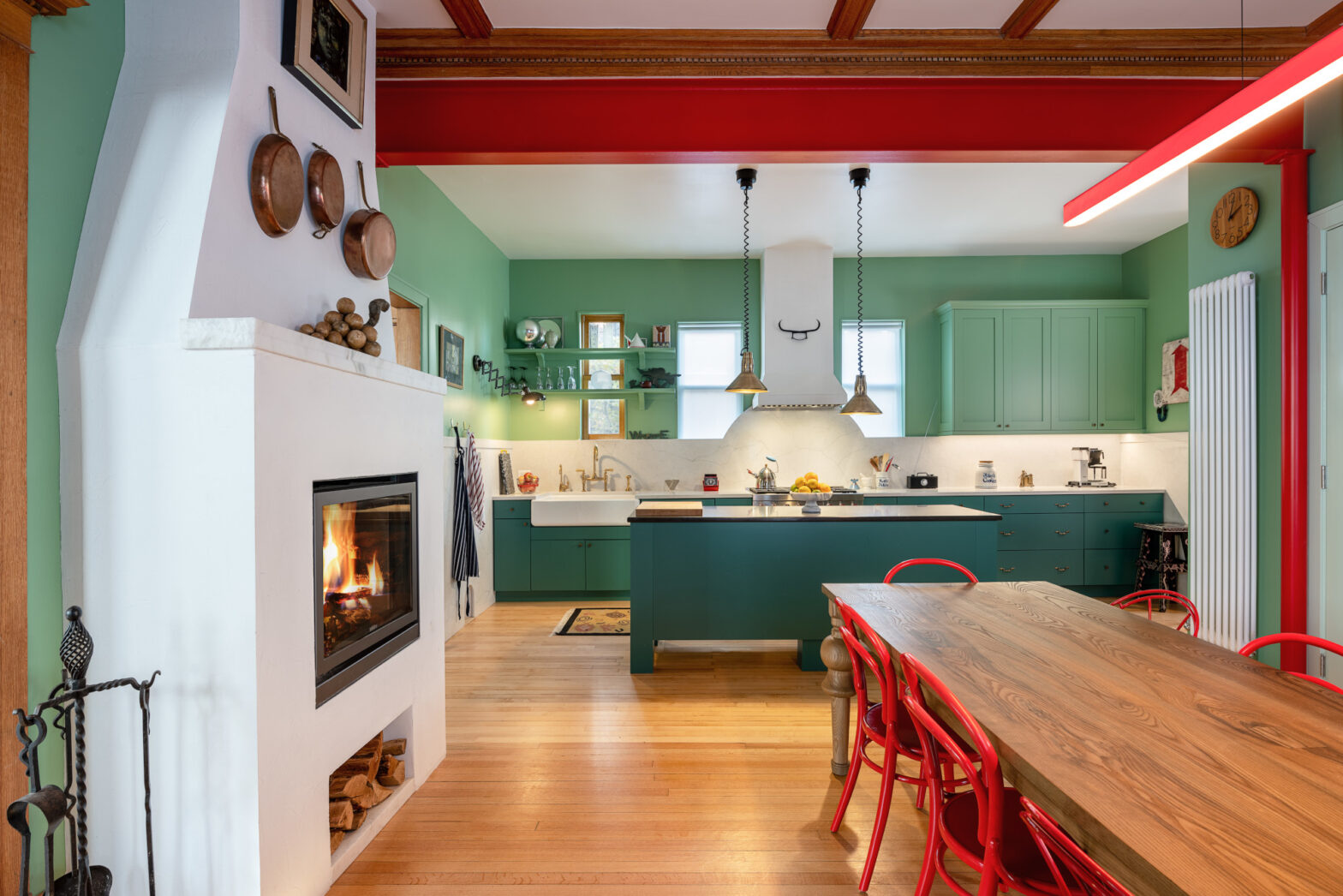Sept. 2023 Ι Dwell
An architect/preservationist and a city planner/1980s-vibe channeler, Jonathan Solomon and Meg Gustafson are fluid aesthetic experts. But when it came time to design a house together after getting married, they weren’t interested in a ground-up project. They wanted “something that already had authenticity,” says Meg. But also “something that we wouldn’t feel too bad about messing with,” says Jonathan. He was coming from a sprawling, prewar, four-bedroom condo in Chicago’s Lincoln Park neighborhood; Meg was leaving an 1885 worker’s cottage in Bridgeport on the city’s South Side.
An 1896 two-and-a-half-story filled with quirky details in the Uptown neighborhood fit the bill. It was the perfect setting for them to assemble their collection of pieces representing what they consider the progressive frontier of historic preservation: postmodernism, Memphis, and other recent historical styles of design. To create the space for this archival swirl, the house embraces “fake authenticity,” says Jonathan, who designed the interiors with Meg. “We’re not shy about bringing in new things that helped it look old.” From the rustic Venetian plaster hearth in the kitchen to the new hot water radiators, dropping faux-historicist elements next to amorphous Austin Powers–esque set-piece furniture and wall-mounted swipes of neon light creates just enough chaos to let design artifacts from any era play well together.
Meg, who works in Chicago’s planning department, runs the 67,000-follower @80s_deco Instagram account, and she’s become expert at translating the online churn of stylistic nostalgia into interiors. Their Uptown house is the product of “eight months of Pinterest boards,” she says, but it’s not just an act of curation. In the kitchen, a tall radiator affixed to the wall is a sculptural presence and a vertical counterpoint to a fire-truck red I-beam above, installed so that Meg and Jonathan’s architect, Keefer Dunn, who handled the structural elements of the renovation, could remove a wall and convert the space into an open plan. It’s a bit of an earnest Miesian moment in a place otherwise filled with smirks. In contrast, the kitchen cabinets and walls are different shades of green, which Meg says she likes because “it’s soothing and a little bit weird.” It isn’t an intuitive fit for Jonathan. “Accepting color on walls was probably the hardest thing for me,” he says. “I was a little weirded out.” The color schemes of Gae Aulenti’s Cadorna train station in Milan and Bruce Goff’s Ford House helped sell him on it.
Upstairs, past a tight stairwell packed with art (like Meg’s grandmother’s drawings of the Chicago skyline) are the library, bedrooms for Jonathan’s two sons (plus a bathroom), a laundry room, and the primary suite. The primary bathroom is a bit gonzo, wrapped in glass block windows and filled with even more neon. A dining cart used as a bathroom caddy, designed by Joey Manic, aka Joseph Boron, has enough metal filigree to evoke a goofily curdled utopia while you brush your teeth. “It’s very Terry Gilliam, in a way, kinda Brazil,” says Meg.
Both of Jonathan’s grandfathers were architects, and he inherited some of their considerable archives. A multigenerational passion for ephemera extends to a peculiar closet at the base of the stairs. It’s too shallow to hang a coat in, yet it bumps out the perimeter of the house. (There’s also a window for some reason.) In it, Jonathan has curated an exhibition closet filled with inherited toys, his own, and newly acquired ones given to him by his sons. “You’re such a good archivist,” says Meg to Jonathan, adding, “He loves paperwork.”
The question of what society keeps is one Jonathan has been working on for a while. Beyond his teaching post at the School of the Art Institute of Chicago, Preservation Futures, which he co-founded, has been a leading voice for the preservation of Helmut Jahn’s masterpiece, The Thompson Center. “We’re dealing with a generation of preservationists now who came of age saving Louis Sullivan, Frank Lloyd Wright, and maybe Mies van der Rohe,” he says. “And they are not prepared for brutalism, postmodernism, and beyond.”
Jonathan and Meg are. He’s interested in “expanding it beyond an approach that imagines a special, frozen moment in which buildings are perfect and they have to be held at,” he says. “I think of preservation as the ongoing care of the built environment. It’s not an absolute. It doesn’t have to be a battle. And this house represents a negotiation between past, present, and future, between Meg and I and our cats and my kids.”
